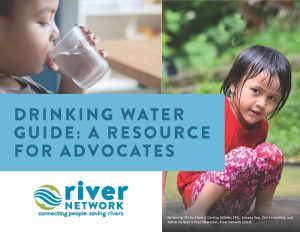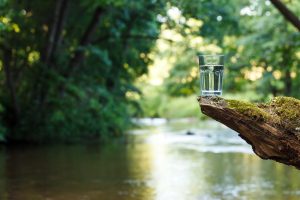Drinking Water Guide – Ready to Use!
I’ve worked on water policy and advocacy issues for more years than I’d like to admit… But, as River Network started to respond to our community’s desire for more resources and tools to address drinking water issues they face, I was overwhelmed by all of the things I didn’t know. I understood where our water comes from. Nationally about two-thirds of our drinking water comes from our streams, rivers, and lakes (which are currently at-risk) – but what then? How is the water treated? Which laws safeguard our drinking water? Who sets drinking water rates? How are water pipes and treatment plants funded? And how do we make sure that everyone has access to clean, safe, and affordable drinking water while also ensuring investment in water systems?
make sure that everyone has access to clean, safe, and affordable drinking water while also ensuring investment in water systems?
Drinking water touches all of us, and yet many of us take it for granted that we can turn on our faucet and expect the water to be there, to be clean and safe, and also affordable to cover our basic needs. Drinking water crises in the Great Lakes – including elevated lead levels in Flint, algal outbreaks in Toledo, water shutoffs in Detroit, and toxic fluorinated chemicals throughout the region – cut to the heart of that belief and made us all think more deeply. Issues of access, safety and affordability have emerged across the country from West Virginia to California’s Central Valley.
More than that, these issues do not always cut equally across our communities. Drinking water availability and health violations vary by race and class. Groups and coalitions like PolicyLink’s Water Equity and Climate Resilience Caucus, We The People of Detroit and many others are bringing these issues to the front of policy discussions where they belong.
Our drinking water systems are fundamental to our health, economy, and well-being, and water systems continue to invest billions of dollars annually, mostly at the local level, in an effort to keep our water safe to drink, many of them with great success despite daunting challenges. These challenges are many and include: aging infrastructure, active and legacy resource contamination, climate change, mismanagement, a convoluted regulatory framework, and a shortage of funding.
Better understanding these issues is part of the solution to advocating for and achieving clean, safe and affordable drinking water for all. With the support of the Charles Stewart Mott Foundation, River Network developed our new Drinking Water Guide to serve as a resource for groups seeking to engage on drinking water safety, sustainability and access at the local, state or national level.
We were supported by ERG and Jumana Vasi and guided by a diverse, Great Lakes-based Advisory Group,* as well as input from watershed and water advocacy groups and environmental justice and community-based organizations from around the country through participation in a series of peer calls and individual outreach. The Guide is divides into the following sections to reflect the issues and concerns raised by all of this feedback:
- Where does our drinking water come from and how can we protect it?
- What does my drinking water system do?
- What frameworks are in place to ensure our water is safe to drink?
- What does drinking water cost and what is my water bill paying for?
- How will climate change affect my water and what can we do about it?
- How can I support community advocacy and engagement on drinking water issues?
Also included are stories of amazing people and strong groups already working for solutions in their communities and making change happen where it’s needed as well as links to many excellent resources created by community, industry, and governmental organizations. The Guide will also be translated and available in Spanish (download the Spanish edition here). Look for a series of webinars to start learning more. As always, send us your feedback and ideas on the Drinking Water Guide and for further training that could support you in your work.
Working on this Guide inspired me to reach out to my own water system, the Orange County Water and Sewer Authority. I sat down with the system’s Sustainability Manager, Mary Tiger, and learned more about what I drink every day and how our system operates, including a partnership to have our local Interfaith Council administer water rate assistance to make it easier to access services all in one place.
There’s a lot to be done and I’m excited to continue learning and River Network is committed to supporting groups and coalitions working on these issues to be effective advocates and partners in our work for clean, safe and affordable water.
You can read and download the Drinking Water Guide at www.rivernetwork.org/drinking-water-guide.
*Drinking Water Guide Advisory Group Members:
James Clift, Michigan Environmental Council
Sheyda Esnaashari, Alliance for the Great Lakes
Irene Folstrom, Minnesota Environmental Partnership
Zoe Roller, US Water Alliance
Monica Lewis-Patrick, We the People of Detroit
Oluwole McFoy, Buffalo Water
Justin Nickels, Mayor, City of Manitowoc, WI
Juani Olivares, Genesee County Hispanic and Latino Collaborative
David Reckhow, University of Massachusetts
Laura Rubin, Huron River Watershed Council
Oday Salim, National Wildlife Federation




